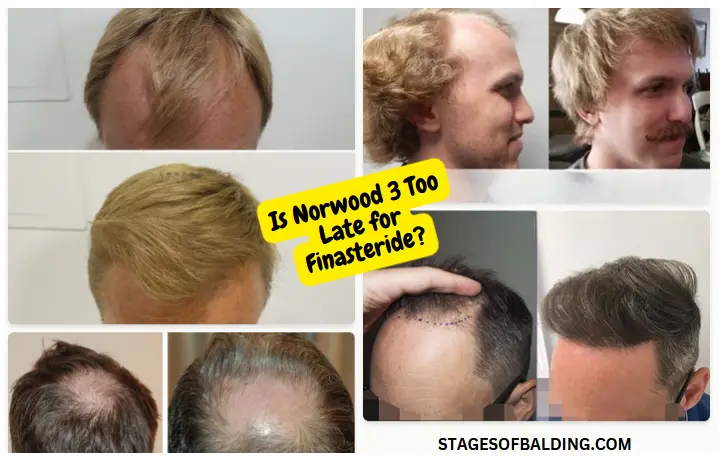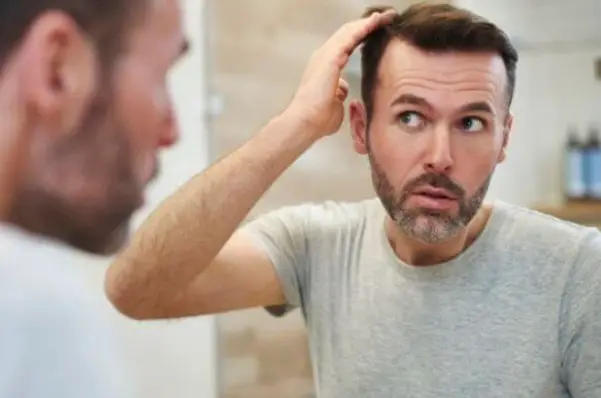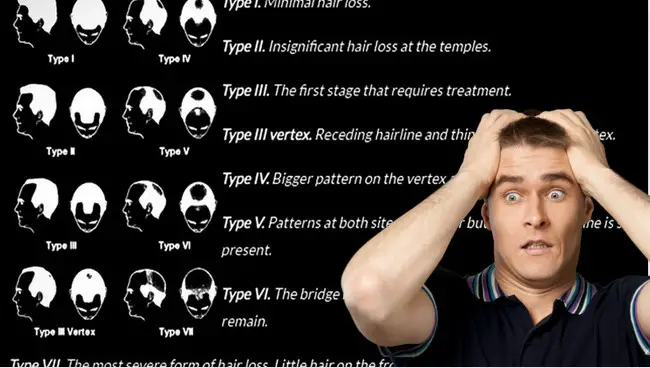Is Norwood 3 too late for finasteride? This is a question that many men ask when they start to experience hair loss.
If you’re experiencing hair loss, you may have heard of Norwood 3 and finasteride. Norwood 3 refers to a stage of hair loss in which the hairline has receded further back than in a Norwood 2 stage, and finasteride is a medication that is commonly used to treat hair loss. But is Norwood 3 too late for finasteride to be effective?
Understanding the Norwood 3 stage is important in determining whether finasteride is a viable option for you. At this stage, the hair loss is more significant than in a Norwood 2 stage, and the hairline has receded further back. However, it is still possible to see significant improvement with the use of finasteride.
Finasteride works by blocking the hormone responsible for hair loss, which can slow down or even reverse the hair loss process. While it is not a guaranteed solution, it has been shown to be effective in many cases. It is important to note that finasteride is not a cure for hair loss, and results may vary from person to person. Additionally, there are potential side effects to consider.
Understanding Norwood 3 Stage
If you are experiencing hair loss, you may be wondering what stage of hair loss you are in. One of the most common ways to classify hair loss is by using the Norwood Scale. The Norwood Scale is a seven-stage scale that measures the severity and pattern of male pattern baldness.
Norwood Stage 3 is often the first indicator of male pattern baldness. During this stage, your hairline will start to develop a more pronounced ‘M’ shape when viewed from above. This is because the hairline is receding from the temples, and the hair in the middle is thinning.
It is important to note that hair loss affects everyone differently. Some people may experience more severe hair loss at an earlier stage, while others may experience less severe hair loss even at a later stage. This is why it is important to consult with a doctor or hair loss specialist to determine the best course of action for you.
If you are in Norwood Stage 3, it is not too late to start using finasteride. Finasteride is an FDA-approved medication that has been shown to be effective in treating male pattern baldness. Finasteride works by blocking the production of DHT, a hormone that is responsible for shrinking hair follicles. By blocking DHT, finasteride can help prevent further hair loss and even promote hair regrowth.
It is important to note that finasteride may not work for everyone, and it may take several months to see results. Additionally, like all medications, finasteride may have side effects. Common side effects include decreased libido, erectile dysfunction, and decreased se-men volume. However, these side effects are usually reversible and go away once you stop taking the medication.
In summary, Norwood Stage 3 is often the first stage of male pattern baldness, and it is not too late to start using finasteride to prevent further hair loss and promote hair regrowth. However, it is important to consult with a doctor or hair loss specialist to determine the best course of action for you and to be aware of the potential side effects of finasteride.
Related Post:
- Norwood 3 Vertex: The Best Hair Loss Solution?
- Stage 3 Hair Loss Treatment
What Is Finasteride
Finasteride is a medication that is used to treat male pattern baldness, also known as androgenetic alopecia. It is an oral medication that works by blocking the conversion of testosterone to dihydrotestosterone (DHT), which is the hormone responsible for hair loss in men. By reducing the levels of DHT in the body, finasteride can help to slow down or even reverse hair loss.
Finasteride is a type of medication known as a 5-alpha-reductase inhibitor. It was originally developed to treat benign prostatic hyperplasia (BPH), a condition in which the prostate gland becomes enlarged and causes urinary problems. However, it was later discovered that finasteride could also be used to treat male pattern baldness.
Finasteride is available in two different strengths: 1mg and 5mg. The 1mg dose is used to treat male pattern baldness, while the 5mg dose is used to treat BPH. It is important to note that the 5mg dose should not be used to treat male pattern baldness, as it can increase the risk of side effects.
Finasteride is generally well-tolerated, and most men do not experience any serious side effects. However, some men may experience side effects such as decreased libido, erectile dysfunction, and decreased e-ja-cu-late volume. These side effects are usually mild and go away once the medication is stopped.
It is important to note that finasteride is not a cure for male pattern baldness. It can help to slow down or even reverse hair loss, but it cannot regrow hair that has already been lost. It is also important to continue taking finasteride for as long as you want to maintain the benefits, as stopping the medication can cause hair loss to resume.
Effectiveness of Finasteride at Norwood 3 Stage
If you are experiencing hair loss at Norwood 3 stage, you might be wondering if finasteride can help. While there is no cure for male pattern baldness, finasteride is an FDA-approved medication that can help slow down hair loss and even promote hair growth in some cases. In this section, we will explore the effectiveness of finasteride at Norwood 3 stage based on scientific studies and anecdotal evidence.
Scientific Studies
Several scientific studies have examined the effectiveness of finasteride in treating male pattern baldness. One study published in the Journal of the American Academy of Dermatology found that finasteride was effective in slowing down hair loss and promoting hair growth in men with mild to moderate hair loss. The study followed 1553 men over a period of two years and found that 83% of men who took finasteride had either maintained or increased their hair count, compared to 28% of men who took a placebo.
Another study published in the International Journal of Dermatology found that finasteride was effective in promoting hair growth in men with androgenetic alopecia. The study followed 118 men over a period of 12 months and found that those who took finasteride had a significant increase in hair count and hair density compared to those who took a placebo.
Anecdotal Evidence
While scientific studies provide evidence of the effectiveness of finasteride, anecdotal evidence can also be useful in understanding how the medication works in real-life situations. Many men with Norwood 3 stage hair loss have reported positive results after taking finasteride, including slowed down hair loss and even regrowth of hair.
However, it is important to note that individual results may vary. Some men may not respond to finasteride, while others may experience side effects such as decreased libido or erectile dysfunction. It is also important to note that finasteride must be taken continuously to maintain its effectiveness. Once the medication is stopped, hair loss will resume.
While finasteride may not be a cure for male pattern baldness, it can be effective in slowing down hair loss and promoting hair growth in some men with Norwood 3 stage hair loss. Scientific studies and anecdotal evidence support the effectiveness of finasteride, but individual results may vary. If you are considering finasteride, it is important to consult with a healthcare professional to determine if it is the right treatment option for you.
Potential Side Effects of Finasteride
Finasteride is a medication used to treat hair loss in men and is generally well-tolerated. However, like any medication, it can cause side effects. It is important to understand the potential side effects of finasteride before taking it.
The most common side effects of finasteride include decreased libido, erectile dysfunction, and decreased se-men volume. These side effects are usually mild and go away once you stop taking the medication. However, in rare cases, these side effects can persist even after stopping the medication.
Other less common side effects of finasteride include breast tenderness or enlargement, rash, itching, hives, and swelling of the lips and face. If you experience any of these side effects, you should contact your doctor immediately.
In rare cases, finasteride can cause serious side effects such as depression, anxiety, and suicidal thoughts. If you experience any of these side effects, you should seek medical attention immediately.
It is important to note that finasteride can also affect the results of prostate-specific antigen (PSA) tests, which are used to screen for prostate cancer. If you are taking finasteride, you should inform your doctor before having a PSA test.
Overall, finasteride is a safe and effective medication for treating hair loss in men. However, it is important to understand the potential side effects and to contact your doctor if you experience any of them.
Alternatives to Finasteride
If you are experiencing hair loss and are not a good candidate for finasteride, there are other options you can explore. Here are some alternatives to finasteride:
Minoxidil
Minoxidil is a topical solution that is applied directly to the scalp. It is FDA-approved to treat hair loss and can help stimulate hair growth. It works by widening blood vessels in the scalp, which increases blood flow and nutrients to hair follicles. Minoxidil is available over-the-counter and can be used by both men and women.
Hair Transplant Surgery
Hair transplant surgery involves taking hair from a donor area (usually the back of the head) and transplanting it to the balding areas of the scalp. This procedure can be expensive and may require multiple sessions, but it can provide a long-lasting solution to hair loss. Hair transplant surgery is most effective for those with limited hair loss and a healthy donor area.
Low-Level Laser Therapy
Low-level laser therapy (LLLT) is a non-invasive treatment that uses light energy to stimulate hair growth. It works by increasing blood flow to the scalp and promoting cellular activity in hair follicles. LLLT can be administered through a handheld device or a laser cap and is typically used for 20-30 minutes per session, a few times per week.
Hairpieces and Wigs
Hairpieces and wigs are a non-surgical option for those who want to cover up hair loss. They are available in a variety of styles and can be custom-made to match your hair color and texture. Hairpieces and wigs can be made from synthetic or human hair and can provide a natural-looking solution to hair loss.
You Will Like:
Hair Thickening Products
Hair thickening products, such as DHT blocking shampoos, conditioners, and styling products, can help improve the appearance of thinning hair. These products work by coating the hair shaft and adding volume and thickness. While they do not address the underlying cause of hair loss, they can provide a temporary solution for those looking to improve the look of their hair.
Conclusion
In conclusion, Norwood 3 is not too late for finasteride. Finasteride is a medication that has been proven to be effective in treating male pattern baldness. It works by blocking the conversion of testosterone to dihydrotestosterone (DHT), a hormone that is responsible for hair loss in men.
While it is true that the earlier you start taking finasteride, the better the results will be, it is still effective at Norwood 3. Many men have had success in regrowing hair and slowing down the progression of hair loss by taking finasteride at Norwood 3.
However, it is important to note that finasteride is not a miracle cure for hair loss. It may take several months to see results, and it may not work for everyone. Additionally, there are potential side effects to consider, such as decreased libido and erectile dysfunction.
If you are considering taking finasteride for Norwood 3 hair loss, it is important to consult with a healthcare professional first. They can help you determine if finasteride is right for you and monitor any potential side effects.
Overall, while Norwood 3 may seem like a significant stage of hair loss, it is not too late for finasteride. With proper use and monitoring, finasteride can be an effective treatment option for men experiencing hair loss at this stage.
Frequently Asked Questions
Can finasteride still work after a year of use?
Yes, finasteride can still work after a year of use. In fact, it is recommended to use finasteride for at least a year to see the full benefits. It is important to note that results may vary and some individuals may not see significant improvement even after a year of use.
What are the common side effects of finasteride?
The common side effects of finasteride include decreased libido, erectile dysfunction, and decreased e-ja-cu-late volume. However, these side effects are rare and usually resolve after discontinuing the medication.
At what age is finasteride no longer effective?
Finasteride is effective for men of all ages, but it is most effective when used in the early stages of hair loss. It is recommended to start using finasteride as soon as possible to prevent further hair loss.
Can finasteride stop hair loss at Norwood 3?
Finasteride can stop hair loss at Norwood 3, but it may not be able to regrow hair that has already been lost. It is important to note that results may vary and some individuals may not see significant improvement.
What are some other options for treating Norwood 3 hair loss?
Other options for treating Norwood 3 hair loss include minoxidil, hair transplant surgery, and low-level laser therapy. It is important to consult with a healthcare professional to determine the best treatment option for you.
What are the typical results of finasteride after 3 months of use?
According to research, it usually takes around 4-6 months for hair to become visibly thicker. So few research studies measure hair growth at just 3 months post-treatment, and not all finasteride users will see significant results at this interval. It is important to note that results may vary and some individuals may not see significant improvement even after 3 months of use.
- AI Powered Bald Filter Online 2024: See Yourself with No Hair! - January 19, 2024
- Harklinikken Bad Reviews 2024: Analyzing Negative Feedbacks - January 18, 2024
- How to Get the Alex Eubank Hair | Step-By-Step Tutorial 2024 - January 18, 2024







